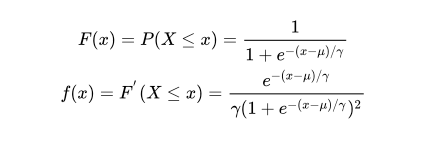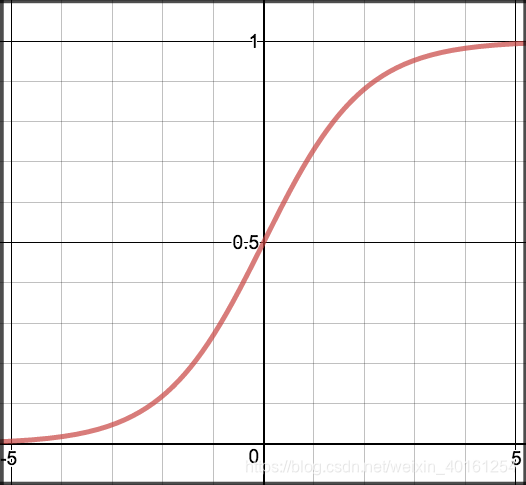参考Logistics Regression
参考 李航.统计学习方法[M].清华大学出版社
概述
- 本质上是一个分类模型,常用于二分类
- 本质: 假设数据服从这个分布,然后使用极大似然估计做参数的估计
Logistic分布
logistic 分布是一种连续型的分布,其分布函数和密度函数分别为:

u 表示位置参数,
r
r
r>0 为形状参数。 logistic 分布是由其位置参数和尺度参数 定义的连续分布。其分布的形状与正态分布形状相似,但其尾部更长。
逻辑回归和线性回归比较
线性回归预测输出的是连续值
线性表达式:
f
(
x
)
=
w
t
x
+
b
f(x)=w^tx+b
f(x)=wtx+b
为了消除掉后面的常数项b,我们可以令
x
′
=
[
1
x
]
T
x^{\prime}=\left[\begin{array}{ll}{1} & {x}\end{array}\right]^{T}
x′=[1x]T ,同时
w
′
=
[
b
w
]
T
w^{\prime}=\left[\begin{array}{ll}{b} & {w}\end{array}\right]^{T}
w′=[bw]T ,也就是说给x多加一项而且值恒为1,这样b就到了w里面去了,直线方程可以化简成为
f
(
x
′
)
=
w
′
T
x
′
f\left(\boldsymbol{x}^{\prime}\right)=\boldsymbol{w}^{\prime T} \boldsymbol{x}^{\prime}
f(x′)=w′Tx′
逻辑回归输出的是离散的值
分为二分类和多分类
为了得到预测概率值。我们用sigmoid激活函数。
g
(
z
)
=
1
1
+
e
−
z
g(z)=\frac{1}{1+e^{-z}}
g(z)=1+e−z1
g(𝑧) in [0,1]
z
=
w
t
x
+
b
z=w^tx+b
z=wtx+b

逻辑回归模型
h
θ
(
x
)
=
θ
0
+
θ
1
x
1
+
θ
2
x
2
+
⋯
+
θ
n
x
n
h_{\theta}(x)=\theta_{0}+\theta_{1} x_{1}+\theta_{2} x_{2}+\cdots+\theta_{n} x_{n}
hθ(x)=θ0+θ1x1+θ2x2+⋯+θnxn
逻辑回归的假设函数可以表示为
h
θ
(
x
)
=
g
(
θ
T
x
)
h_{\theta}(x)=\mathrm{g}\left(\theta^{T} x\right) \quad
hθ(x)=g(θTx)
g
(
z
)
=
1
1
+
e
−
z
g(z)=\frac{1}{1+e^{-z}}
g(z)=1+e−z1
即
y
=
1
→
θ
T
x
≥
0
y
=
0
→
θ
T
x
<
0
\begin{array}{l}{y=1 \quad \rightarrow \quad \theta^{\mathrm{T}} x \geq 0} \\ {y=0 \quad \rightarrow \quad \theta^{\mathrm{T}} x<0}\end{array}
y=1→θTx≥0y=0→θTx<0
注意
g
(
z
)
=
1
1
+
e
−
z
=
e
z
1
+
e
z
g(z)=\frac{1}{1+e^{-z}}=\frac{e^{z}}{1+e^{z}}
g(z)=1+e−z1=1+ezez
g
(
−
z
)
=
1
−
1
1
+
e
−
z
=
1
1
+
e
z
g(-z)=1-\frac{1}{1+e^{-z}}=\frac{1}{1+e^{z}}
g(−z)=1−1+e−z1=1+ez1
二项逻辑回归模型是如下的条件概率分布:
P ( y = 1 ∣ x , θ ) = 1 1 + e − θ T x = e θ T x 1 + e θ T x \mathrm{P}(\mathrm{y}=1 | \mathrm{x}, \theta)=\frac{1}{1+e^{-\theta^{T} x}}=\frac{e^{\theta^{T} x}}{1+e^{\theta^{T} x}} P(y=1∣x,θ)=1+e−θTx1=1+eθTxeθTx p ( y = 0 ∣ x , θ ) = 1 1 + e − θ T x = 1 − p ( y = 1 ∣ x , θ ) = p ( y = 1 ∣ x , − θ ) = 1 1 + e θ T x \mathrm{p}(\mathrm{y}=0 | \mathrm{x}, \theta)=\frac{1}{1+e^{-\theta^{T} x}}=1-p(\mathrm{y}=1 | \mathrm{x}, \theta)=\mathrm{p}(\mathrm{y}=1 | \mathrm{x},-\theta)=\frac{1}{1+e^{\theta^{T} x}} p(y=0∣x,θ)=1+e−θTx1=1−p(y=1∣x,θ)=p(y=1∣x,−θ)=1+eθTx1
pyspark 应用
- 定义
class pyspark.ml.classification.LogisticRegression(featuresCol='features', labelCol='label', predictionCol='prediction', maxIter=100, regParam=0.0, elasticNetParam=0.0, tol=1e-06, fitIntercept=True, threshold=0.5, thresholds=None, probabilityCol='probability', rawPredictionCol='rawPrediction', standardization=True, weightCol=None, aggregationDepth=2, family='auto', lowerBoundsOnCoefficients=None, upperBoundsOnCoefficients=None, lowerBoundsOnIntercepts=None, upperBoundsOnIntercepts=None)
- 官方demo
bdf = spark.createDataFrame([
Row(label=1.0, weight=1.0, features=Vectors.dense(0.0, 5.0)),
Row(label=0.0, weight=2.0, features=Vectors.dense(1.0, 2.0)),
Row(label=1.0, weight=3.0, features=Vectors.dense(2.0, 1.0)),
Row(label=0.0, weight=4.0, features=Vectors.dense(3.0, 3.0))])
blor = LogisticRegression(regParam=0.01, weightCol="weight",rawPredictionCol='rawPrediction')
blorModel = blor.fit(bdf)
# print(type(blorModel)) #<class 'pyspark.ml.classification.LogisticRegressionModel'>
# print(dir(blorModel))
print(blorModel.coefficients)
test0=spark.createDataFrame([Row(features=Vectors.dense(-1.,1.))])
result=blorModel.transform(test0)
result.show()
"""
+----------+--------------------+--------------------+----------+
| features| rawPrediction| probability|prediction|
+----------+--------------------+--------------------+----------+
|[-1.0,1.0]|[-3.5472025573965...|[0.02799860485691...| 1.0|
+----------+--------------------+--------------------+----------+
"""
# print(dir(result))
print(result.select('probability').take(1))
print(result.select('rawPrediction').take(1))
# [Row(probability=DenseVector([0.028, 0.972]))]
# [Row(rawPrediction=DenseVector([-3.5472, 3.5472]))]
- 释义
如果是二分类
rawPrediction 等同于wx + b
pbobability 等同于1/(1+e^-(wx + b))
prediction 为0 或1 - 参数解释
featuresCol=“features”: 输入训练集和预测数据集中的属性向量的字段名称
labelCol=“label”: 输入训练集集中的标记字段
predictionCol=“prediction”: 输出结果中判别字段名称
maxIter=100: 迭代算法的最大迭代次数
regParam=0.0: 正则化惩罚程度参数
elasticNetParam=0.0: 正则化时弹性网络调整参数
tol=1e-6:收敛容忍系数(convergence tolerance),算法每次迭代后的比较阈值来确定算法是否结束,值越小,可能执行的迭代次数就越多。
fitIntercept=True: 是否使用带截距的回归
threshold=0.5:
thresholds=None:
probabilityCol=“probability”, 输出结果概率值名称
rawPredictionCol=“rawPrediction” :输出结果数据中回归因变量值的字段名称
standardization=True:是否在回归前对训练集中的属性数据做标准化处理
weightCol=None: 权重
aggregationDepth=2:Spark迭代计算过程中才用treeAggregate的方式来reduce各个分区数据,这里的参数可以用来调整treeAggregate的层次深度,层次越深reduce时用到的执行节点更多,能并行的数据量就越多。(>=2的整数,默认值2)
family=“auto”:
可选项
1 binomial 二分类
2 multinomial 多分类
3 auto 自动选择
lowerBoundsOnCoefficients=None:
系数的下限约束,能够支持设置多分类(矩阵中每个向量代表一个分类系数)的系数。(矩阵类型,无默认值)
upperBoundsOnCoefficients=None:系数的上限约束,能够支持设置多分类(矩阵中每个向量代表一个分类系数)的系数。(矩阵类型,无默认值)
lowerBoundsOnIntercepts=None: 常量系数(截距)的下限约束,能够支持设置多分类(向量中每个分量代表一个分类系数)的截距。(向量类型,无默认值)upperBoundsOnIntercepts=None:常量系数(截距)的上限约束,能够支持设置多分类(向量中每个分量代表一个分类系数)的截距。(向量类型,无默认值)
























 7885
7885











 被折叠的 条评论
为什么被折叠?
被折叠的 条评论
为什么被折叠?








